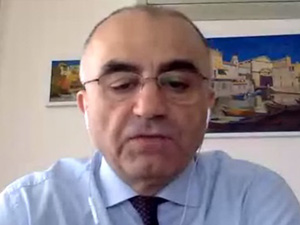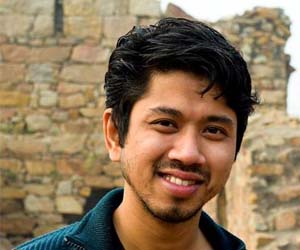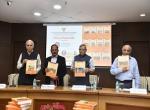The Vivekananda International Foundation organised a virtual interactive session on the subject, “Armenian Genocide: History and Perspective” on 24 April 2020. Dr Arvind Gupta, Director, VIF delivered his opening remarks highlighting the relevance of history to understand the current geopolitics of Armenia, Turkey and the region in general. The Director, VIF posed question on the recurrence of genocide in the present period and conflicting interpretations about the genocide that occured between 1915 and 1924. Amb. Armen Martirosyan, Armenian Ambassador to India; Dr. Suren Manukyan, Visiting Lecturer at the American University of Armenia; Dr. Suman Keshari, Social Activist and Prof. Ashwini Mahapatra, Centre for West Asian Studies, Jawaharlal Nehru University participated in the discussion.
The talk held on the 105th anniversary of the Armenian Genocide perused on the three fold significance. Firstly, to pay tribute to the fallen Armenians; secondly, to remind the world about the gruesome event and learn lesson and thirdly, to explore new ways to address the subject and globally promote recognition of the genocide. The crucial contribution of internet in democratising experience-sharing and raising global consciousness was raised by Amb. Armen Martirosyan. The US Congress, despite opposition by the Turkish President Recep Tayip Erdogan, recognised the Armenian genocide on 12 December 2019. The Armenian Genocide is currently recognised by 34 states. Dr. Suman Keshari announced a book compilation in Hindi to educate about the history and the context of the Armenian genocide which would be highly helpful in India.
The term ‘genocide’ was coined in 1943 by Raphael Lemkin and the UN General Assembly adopted Convention on the Prevention and Punishment of the Crime of Genocide on 9 December in 1948. Therefore, the said tragedy occurred before the terminology was conceived and internationally accepted conventions were implemented. In the contemporary period, the international conventions concerning crimes against humanity however have failed to prevent mass atrocities with numerous instances of ethnic cleansing occuring in Rwanda, Cambodia and Sudan. Ethnic cleansing in the post World War II became part of the politcal culture and ‘acceptable’ tool to solve inter-ethnic problems.
The subject of recurrence of genocide in the contemporary period was delved in detail. Amb. Martirosyan cited J S Mill’s argument that democratic decision-making can occur only after ethnic differences are minimised. While the prevalence of democratic procedure does not strictly require homogenous society, it does require a certain level of unity and trust among various ethnic groups. The process of decision-making in the absence of such conditions, could disrupt peaceful co-existence which may have violent ramifications. Therefore, in order to eliminate differences in multi-ethnic societies, states resort to assimilation, expulsion, partition and genocide.
In term of the root causes of the Armenian genocide, three major interpretations were highlighted. The first interpretation emphasises on the geopolitical explanation especially the Armenian-Russian alliance in the World War I in which a sizeable number of Armenian volunteers joined the Imperial Russian Army to fight against the Central Powers including Ottoman Turkey. The geopolitical explanation however, has failed to explain the structural level discrimination and violence against Armenians that persisted prior to the World War I. The second interpretation points to the economic aspect in which Armenians held disproportionate amount of wealth in the empire. The third interpetation focuses on the political consolidation process by the Young Turk movement led by Kemal Mustafa Ataturk.
Armenian Christian minority living mostly in the eastern parts of the empire as well as in the capital, Istanbul had been an integral part and contributed immensely in the educational, banking, commercial, cultural spheres in Ottoman society. By the mid 1800s, there was a rise in political awakening among the Armenians that questioned about their second class status as citizens of the Ottoman state.
The empire facing series of defeats and rebellions used violence as a tool to propagate unity and resolve domestic issues. During the rule of Sultan Abdul Hamid II, 300,000 Armenians were killed in what came to be known as Hamadian massacres between 1894 and 1896. The demand for reforms prior and during the World War I was perceived as an existential threat by the weak Ottoman state. It created the conditions for social, economic, and cultural suppression of its own citizens belonging to minority groups such as Assyrians, Greeks and Armenians. Amb. Martirosyan opined that a combination of foreign interference, ethnic differences, economic envy, exclusive nationalism and commitment to maintain Turkish political and social dominance prompted the genocide. The Ottoman state therefore resorted to oppression, mass murder, forced conversion, deportation, assimilation and deprivation of the historical homeland that led to killing and expulsion of 1.5 million Armenians between 1915 and 1924.
The question of intent in committing mass atrocities was discussed. The speakers posited that genocide is a pre-meditated structural process rather than an one-time act ranging from hate speech, cultural stereotyping, misinformation, press censorship, institutional level discrimination to state organised violence. The Armenians were subjected to similar measures between 1915 and 1924. Dr. Manukyan pointed that the tradition of impunity offered by the Ottoman state facilitated an atmosphere of normality about killing Armenians.
After the disintegration of the Ottoman state and abolition of the Caliphate in 1922, the Republican Turkey led by the Young Turk movement sought to disentangle from its Ottoman past and create a secular multi-party democracy. The Young Turks perceived the Armenians not as partners but as rivals in the nation-building process. It took measures to erase the cultural identity of minority communities including Armenians. Prof. Ashwini Mahapatra suggested that the Turkish Republic is an artificial state based on the construction of mono-ethnic national identity in a multi-ethnic and multi-religious state. The political structure is officially democratic, however in reality it has shifted from military autocracy to civilian autocracy. Moreover, the state has been unable to resolve the dilemmas between secular state and deeply religious society. In terms of foreign policy, the artificial nature of the state is reflected in the contradictory diplomatic positioning vis-a-vis its neighbours as well as the US and Russia.
On the subject of genocide denial by Turkey, the republican regime selectively re-created its national history to reinforce the mono-ethnic Turkish identity in which other ethnic identities were forcefully integrated. The denial by Turkey to acknowlege the genocide should be seen in terms of identity dilemma stemming from the artificial nature of the Turkish state. The denial of the atrocities has been ingrained in the cultural psyche of Turkish citizens and it has shaped the current animosity between both states. The Turkish authorities regularly exercises press censorship to manipulate public opinion. Article 301 of the Turkish Criminal Code is regularly used to persecute and expel intellectuals. Diplomatically, Turkey has refused to recognise Armenia’s sovereignty after the establishment of state in 1991 and imposed land blockade. Armenia in the spirit of reconciliation has sought normalisation with Turkey without preconditions in 2008, however diplomatic efforts presently remains stalled. Armenia calls for acknowledgement of actions of past governments in the spirit of reconcilation to move forward which would bring stability in the region.
Dr. Manukyan offered an interesting anecdote by suggesting that Turkey is paradoxically the first state to recognise the genocide after the military court in 1919 agreed that the deportations and killings of Armenians did not constitute military or disciplinary measures and penalised few culprits. The court also refuted the claim that it was local in nature. The verdict therefore reflects acknowledgement of the events which the present Turkish state continues to deny.






Post new comment